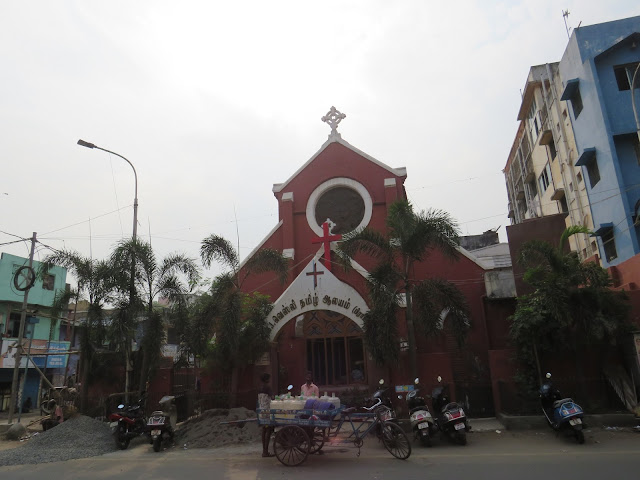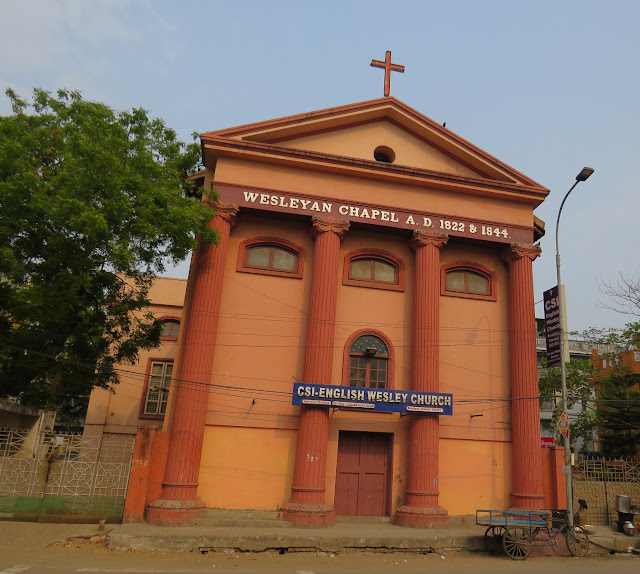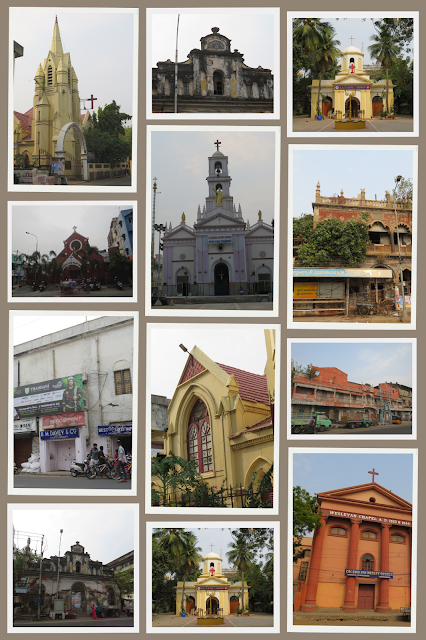Broadway - A Virtual Heritage Walk
I am standing in front of the narrow Road opposite Chennai High Court and wondering -
"Can I drive? No...not possible....ride? Not sure....forget it....I don't think I can even walk on this Road."
"Who named it Broadway? Is it supposed to be a joke?"
Certainly, the ultra-urban youth of today's Chennai who spends their time in ECRs and OMRs would never ever visit this place full of history, a part of the Original Madras.
The southern end of Broadway reminds me a historical incident. It is the same site where Andhra Kesari Prakasam protested opposing the Simon Commission in 1928 CE. When a demonstrator was shot dead, unmindful of police warning, he did a heroic act. He undid his shirt buttons, bared his chest as a challenge, and moved forward to retrieve the martyr's body. Later, his statue was erected here to commemorate this incredible brave deed, and Broadway was named after him as Prakasam Road.
Broadway never ceases to surprise. Almost 80% of heritage structures are gone. Still, walking through the street and observing the remaining structures is exciting. (Of course, you can try walking only on Sunday early morning. ;-) ) It contains so much history and so many untold or forgotten stories.
Broadway might be a civic disaster today. It is difficult to believe that it was the primary commercial establishment for Britishers till the early 20th century. It is furthermore hard to believe that the entire Road was constructed on a gutter.
Yes, an extensive canal called "Atta Pallam" ran from north to south. The locals, primarily Telugus, called it "Pedda Kalva". Stephen Popham, a leading lawyer, bought this drainage channel and the adjoining wasteland.
When the Government wanted to level Hog Hill for security reasons, he drew up a plan that was approved by the Government. Accordingly, he used the residue of Hog Hill to fill the drainage and thus reclaimed the land. Thus, Popham's Broadway was constructed in the 1780s, which obviously made him richer.
Ambi's Cafe would be the first thing to remember on Broadway, as it was technically located as the first shop while entering the Road. After the successful launch of Ambika Lunch Home and Ambi's Cafe in Vellore, Ambi Iyer started its branch here in 1935. The business flourished and remained a landmark of the locality for many decades. Although the restaurant is not surviving anymore, people still have sweet memories of this eatery.
 |
| The oldest surviving cycle shops of Madras |
Broadway had the earliest cycle shops in South India. Many of those shops were started by Gujarati families who migrated to the city in the 1900s.
The English Cycle & Motor Importing Company was perhaps started in the 1920s. The Bombay Cycle Importing Company was located near the famous Ambi's Cafe on Broadway. At one point, it was probably the biggest bicycle store in South India. Next door, there was the South India Cycle store. Nataraja Mudaliar, who produced the first silent movie "Keechaka Vadam," had his own shop, Watson and Co. Manilal Nemchand & Co, and The Kathiavar Cycle & Motor Co were other few cycle stores. Unfortunately, none of them exist anymore.
C.T. Shah and N.D. Mehta started the Popular Cycle Importing Company on Broadway in 1928. The shop does not exist today. However, one of the founders, N.D. Mehta started another shop named "Best Cycle Importing Company" in the early 1930s, which still exists. Bhogilal M. Davey began a cycle shop in Bunder Street in the same locality in 1932. In 1936, the shop was shifted next door to the Best Cycle shop. These two cycle dealers with the old blue-colored name boards alone are still on Broadway. You can find these shops about 200 meters from the southern end of the Road.
(If you want to learn more interesting facts about the oldest cycle stores of Madras, please visit this page.)
During the Second World War, many of these Gujarati businessmen moved to Tirupati temporarily, fearing that Madras might be bombarded. However, they could not get rid of their livelihood. Hence, the male members alone would commute to Madras daily and return to Tirupati by night. This tiresome journey continued for about six months.
Diagonally opposite these shops, the best Gujarati restaurant named Gunavanti Bhavan in the Gujarati Mandal building is located.
.JPG) |
| Gujarati Mandal |
A little away towards the south, we have a small but elegant red-colored British-era building built in simple Indo-Saracenic style. Lakhotia Enterprise, the shop which occupies this heritage structure, has blocked the beauty of the building with its name boards.
There is one more structure within 50 meters. Though it is not very attractive, it belongs to the British era. The ground floor is entirely spoiled; however, the first floor somewhat maintains its original style. Progressive Trading Corporation and another shop are currently located in this building, which is supposed to be categorized as a heritage structure.
Another 50 meters of distance would take us to a beautifully built British-era structure red colored brickwork. It has already lost its 50% of grace thanks to the shops rented out on the ground floor.
About 250 meters away, the historic Tucker Church is located. The beautiful church was named after its second missionary Rev. John Tucker. It was founded by The Church Missionary Society (CMS) in 1820.
(I have covered Tucker Church in detail in a separate article. Please click this link to access the same.)
.JPG) |
| Tucker Church |
Next to the church, there stands a damaged heritage structure, which would have looked majestic originally. On top, the engraving in black stone reveals that it is the Centenary Hall built by CMS in 1901 CE. The dilapidated structure was active with public gatherings till the 1980s. It is sad to find this once-beautiful heritage building getting neglected by passersby.
.JPG) |
| Centenary Hall |
Within 150 meters, we have another historic church. This most beautiful church on Broadway is the Arcot Lutheran Church, built in the Gothic architectural style. The majestic-looking church, formerly known as the Danish Mission Church, was dedicated on 18th December 1892 CE.
(Read my separate article here about the Arcot Lutheran Church.)
.JPG) |
| Arcot Lutheran Church |
About 50 meters from the Arcot Lutheran Church, on the opposite side, there is a huge mansion built in a typical style that prevailed in the pre-independence day in Madras. The structure was constructed in 1923. Hotel Adarsha, a lodge, has been functioning from this 100-year-old building.
A slight diversion into Davidson Street reminds us of the bygone era. The historic Minerva Theatre - the first cinema hall in Madras Presidency to get air-conditioned, the creme de la creme of cine halls in Madras for European clientele, the first theatre in South India to be laid out on the first floor, the first one in the city to introduce noon shows and the theatre that survived for one hundred years.
(I have covered about this theatre and its history in a separate article. If you are interested to know more please visit this page.)
 |
| Minerva Theatre |
Let us come back to the main Road! Within 200 meters come two 19th-century-era churches - CSI Tamil Wesleyan Church, built in 1861, and CSI English Wesley Church, built in 1822. The English Church has not entirely lost its old charm. Then, there is a lesser-known British-era beautiful building called Shadulia Palace.
(I have written separate articles covering all these three places. Click the below links to read them.
 |
| Tamil Wesleyan Church |
.JPG) |
| Shadulia Palace |
 |
| English Wesley Church |
There is hardly anything to observe or appreciate for the next 500 meters. Then comes the historic Broadway theatre. Haridass, the 1944 classic, ran for three years in this theatre. Despite being engulfed with such rich history, hardly anyone from today's Chennai could reminisce about this theatre. It has lost its glory and was closed down.
(Wanna know more about Broadway. Then, click here.)
At least the Broadway theatre has not yet lost its structure, though it stopped functioning. However, its twin theatre, Prabhat, another landmark of the Original Madras, was demolished long back.
 |
| The site where Prabhat Theatre was located once |
There is St. Francis Xavier's Church opposite the multi-story apartment that stands on the site where Prabhat theatre stood once. Though renovated and looks new nowadays, it was built in 1866.
A little away from Prabhat talkies, there is the Beehive building. Once Subash Chandra Bose had a meeting with Muthuramalinga Devar and others here. The "Beehive Foundry" was started in 1893 CE by Oakes & Co. The foundry had specialization in making ships' castings. Also, the building has an air-raid shelter built in 1941 during World War II. It could accommodate up to 100 people. This is one of two such shelters that still remain in the city.
(My detailed article about Beehive Foundry is found here.)
The same Oakes and Co. started general goods stores in 1843 on Broadway. In 1845, they moved the stores to a new building called "Exchange Hall", which was more spacious. The store developed into the biggest departmental store in South India, claiming to have the most extensive stock of general goods. Later, when the business grew further, it moved to Mount Road. The building where the first departmental store of Madras functioned is not surviving anymore, though.
At last, there is Bharati College. It is hard to believe that this site initially had a prison. Hence, the nearby Road is named Old Jail Road.
When the famous Ananda Vikatan became a fortnightly from the monthly magazine, it moved its office from Mint Street to Broadway. But, in which exact building did Ananda Vikatan function? I may have to explore to figure this out.
"The Madras Times" started in 1859 and ultimately became "The Mail", had its origin on Broadway. "The Indian Express" was born in Mooker Nallamuthu Street, a by-lane of Broadway. There are a few other lesser-known magazines, and many publishers such as Poompuhar publishers, Pari Nilayam, and others have their origins here.
Pachaiyappa's Central Institution was started on 1st January 1842 in an Indo-Saracenic building on Broadway with the funds allocated by Pachaiyappa Mudaliar. It was the first non-missionary, non-British-financed educational institution in South India. It became a school in 1850, shifted to its own premises in NSC Bose Road in 1856, and ultimately grew as a college in 1889. Where is that heritage structure where the glorious history of Pachaiyappa's started? I don't know.
The General Post Office, located in a heritage structure in Rajaji Road, was initially located on Broadway. Again, where?
In 1897 CE, a few short clips were screened in Victoria Hall; it was the first cinema viewing experience for the citizens of Madras. Since then, the animated photographs were regularly screened in the same venue and other places like the tents of Esplanade and the Egmore Museum Theatre. However, a permanent theatre with a well-conceived hall was opened only in 1911. It was named "Bioscope" and started by Mrs. Klug on Broadway Street. Unfortunately, no one knows where Bioscope was located on Broadway.
Near the Wesley Church, Dr. Sankaranarayanan, an ENT specialist, started the first private hospital of Madras in 1914. The hospital had 24 beds and the building had three floors. The building perhaps is no more surviving.
The luxurious and popular Harrison's Hotels of Nungambakkam was originally started on Broadway in 1891. It was called Harrison Catering in those days.
P Venkatachellum's, a well-known brand for condiments, started its life on Broadway in 1860. The successful brand occupied many blocks on Broadway during its prime time. "Milagu rasam" sold here was a favorite drink for Europeans, it is said.
As I stated already, Broadway is full of surprises and heritage treasures unknown to the current generation.
Happy travelling.

.JPG)
.JPG)
.JPG)






.JPG)
Thank you for enlightening us on the heritage monuments of Brosdway Madras.
ReplyDeleteThank you.
DeleteThat's awesome write up. Wish to send it to others. Thank you very much. Krishnan
ReplyDeleteMy pleasure.
DeleteFrom the P. Venkatachellum family Mrs. Jothi Venkatachalam was a Minister under the Chief Ministership of Kamaraj in the 1960s.
ReplyDelete